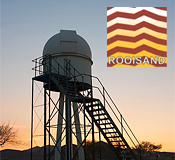 |
ROOISAND OBSERVATORY DeepSky | SITEMAP HOME ROOISAND |
|
 |
|||
| « back to overview Nebulae | Load higher resolution (1800 x 1200 Pixel) | Object description |
Description of object:
One of the first test shots with the new telescope at the Rooisand Desert Ranch in Namibia. The results are quite decent considering the relatively short single and overall exposure time. M8 (the Lagoon Nebula) is one of the brightest emission nebulas in the sky and can already be seen with the naked eye within a dark cloud of the milky way. The view at light magnification through the 17'' CDK PlaneWave is truly breathtaking. The gigantic birthplace of stars is located in the zodiacal sign Sagittarius a little bit more than 5000 light years away. The small central piece is also called Hourglass Nebula because of its shape. The viewing field covers the area of about the half a moon diameter.
The Lagoon Nebula owes its name to dark dust band which cuts the nebula into two parts. The Lagoon Nebula is the prototype of an emission nebula and its physics and structure is similar to the big Orion Nebula which can be seen with the naked eye in the northern hemisphere in winter. However one can also find the other types of galactic nebulas within the Lagoon Nebula: absorbing dark clouds, Bok-globules and reflection nebulas. The Lagoon Nebula is an active birthplace for stars still today.
The open star cluster NGC 6530 lies in one region of the nebula. Its age is projected at 'just' 2 million years. The very hot stars of the cluster once generated the bulk of the high-energy UV radiation which lights the Lagoon Nebula's hydrogen gas. Nowadays those stars have been replaced by the star 9 Sagittarii which ionizes big parts of the nebula. It is the brightest star in the telescope's field of view. Its boring catalogue name falls short of the fact that it is one of the half-dozen brightest stars of our galaxy. The star blasts more energy into space than a million sun-like stars. Its mass is more than a hundred times the mass of our sun and its surface temperature is with 60.000 Kelvin ten times higher than the one of our sun. Although the star is about 6.000 light years away it is not easily observed with the naked eye. Our sun - put into the same distance to earth - could only be made visible with very large telescopes.
On the brightest spot on the other side of the nebula - opposite the star cluster - there is another astronomical superlative. There is concealed - together with a small nebula - one of the youngest known stars, the star Herschel 36. This star is at the most 10.000 years old and still being partly concealed by the gas cloud it was created from. The nebula itself has a characteristic shape. Astronomers call it Hourglass Nebula.
Longer exposed shots show that the Lagoon Nebula is very widely expanded. NGC 6559, as well as IC 1274, IC 1275 and IC 4685 also belong to the complex (Emission nebula, reflection nebula and dark nebula. This region is also called 'the fist'.)
 |
 |
 |
 |
 |
| Moon | Solar System | DeepSky | Widefield | Miscellaneous |